
A knife is a tool or weapon with a cutting edge or blade, usually attached to a handle or hilt. One of the earliest tools used by humanity, knives appeared at least 2.5 million years ago, as evidenced by the Oldowan tools. Originally made of wood, bone, and stone, over the centuries, in step with improvements in both metallurgy and manufacturing, knife blades have been made from copper, bronze, iron, steel, ceramic, and titanium. Most modern knives have either fixed or folding blades; blade patterns and styles vary by maker and country of origin.
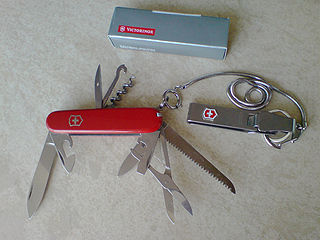
The Swiss Army knife is a pocketknife, generally multi-tooled, now manufactured by Victorinox. The term "Swiss Army knife" was coined by American soldiers after World War II after they had trouble pronouncing the German word "Offiziersmesser", meaning "officer’s knife".

A switchblade is a pocketknife with a sliding or pivoting blade contained in the handle which is extended automatically by a spring when a button, lever, or switch on the handle or bolster is activated. Virtually all switchblades incorporate a locking blade, where the blade is locked against accidental closure when the blade is in the open position. It is unlocked by a mechanism that allows the blade to be folded and locked in the closed position.

A balisong, also known as a butterfly knife, fan knife or Batangas knife, is a type of folding pocketknife that originated in the Philippines. Its distinct features are two handles counter-rotating around the tang such that, when closed, the blade is concealed within grooves in the handles. A latch sometimes holds the handles together; typically mounted on the one facing the cutting edge.
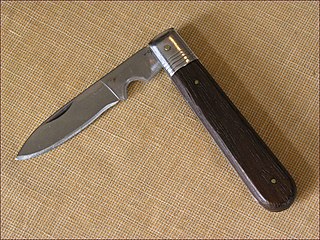
Penknife, or pen knife, is a small folding knife. Today penknife is also the common British English term for both a pocketknife, which can have single or multiple blades, and for multi-tools, with additional tools incorporated into the design.
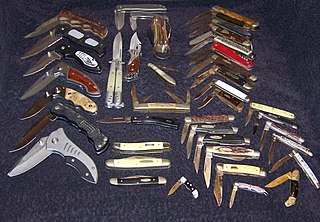
A pocketknife is a knife with one or more blades that fold into the handle. They are also known as jackknives (jack-knife), folding knives, EDC knife, or may be referred to as a penknife, though a penknife may also be a specific kind of pocketknife. A typical blade length is 5 to 15 centimetres.
A gravity knife is a knife with a blade contained in its handle, and that opens its blade through the force of gravity. This mechanism of opening is fundamentally different from the switchblade, which extends its spring-propelled blade automatically upon the push of a button, switch, or fulcrum lever. The main purpose of gravity opening is that it allows opening and closing to be done one handed, in situations where the other hand is occupied. Hence, historically they have been issued to parachutists to cut off caught lines, such as lines tangled in trees, a major potential use of the gravity knife.
The Laguiole knife is a traditional Occitan pocketknife, originally produced in the "knife city" of Thiers, source of 70% of France's cutting tool production, as well as the small village of Laguiole, both located in the Massif central region of France. Laguiole in this instance does not refer to the French knife brand but to a generic type of traditional slipjoint knife associated with this region of France.
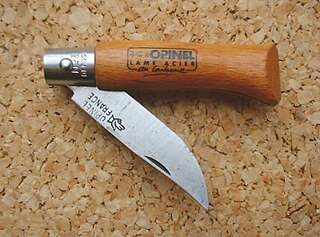
The penny knife was a originally a simple 18th century utility knife with a fixed blade. It got the name penny knife because it cost 1 penny in England and America towards the end of the 18th century.

Buck Knives is an American knife manufacturer founded in Mountain Home, Idaho and now located in Post Falls, Idaho. The company has a long history through five generations of the Buck family from 1902 to the present day. Buck Knives primarily manufactures sport and field knives and is credited with inventing the "folding hunting knife" and popularizing it to such a degree that the term "buck knife" has become synonymous with folding lockback knives, including those made by other manufacturers.

A kitchen knife is any knife that is intended to be used in food preparation. While much of this work can be accomplished with a few general-purpose knives – notably a large chef's knife, a tough cleaver, a small paring knife and some sort of serrated blade – there are also many specialized knives that are designed for specific tasks. Kitchen knives can be made from several different materials.

Survival knives are knives intended for survival purposes in a wilderness environment, often in an emergency when the user has lost most of their main equipment. Most military aviation units issue some kind of survival knife to their pilots in case their aircraft are shot down behind enemy lines and the crew needs tools to facilitate their survival, escape, and rescue. Survival knives can be used for trapping, skinning, wood cutting, wood carving, and other uses. Hunters, hikers, and outdoor sport enthusiasts use survival knives. Some survival knives are heavy-bladed and thick. Other survival knives are lightweight or fold in order to save weight and bulk as part of a larger survival kit. Their functions often include serving as a hunting knife. Features, such as hollow handles, that could be used as storage space for matches or similar small items, began gaining popularity in the 1980s. Custom or semi-custom makers such as Americans Jimmy Lile, Bo Randall, and Chris Reeve are often credited with inventing those features.

Gerber Legendary Blades is an American maker of knives, multitools, and other tools for outdoors and military headquartered in Portland, Oregon. Gerber is owned by the Finnish outdoors products company Fiskars. Gerber was established in 1939 by Pete Gerber.
X-Acto is a brand name for a variety of cutting tools and office products owned by Elmer's Products, Inc. These include hobby and utility knives, saws, carving tools and many small-scale precision knives used for crafts and other applications. An X-Acto knife may be called an Exacto knife, utility knife, precision knife, or hobby knife.
Olfa Corporation is a Japanese manufacturer of utility knives, founded in 1956 in Osaka, Japan. The name is derived from the Japanese words oru and ha. The company is known for inventing the snap-off blade and the rotary cutter.

A hunting knife is a knife used during hunting for preparing the game to be used as food: skinning the animal and cutting up the meat. It is different from the hunting dagger which was traditionally used to kill wild game.

A rotary cutter is a tool generally used by quilters to cut fabric. It consists of a handle with a circular blade that rotates, thus the tool's name. Rotary cutter blades are very sharp, can be resharpened, and are available in different sizes: usually smaller blades are used to cut small curves, while larger blades are used to cut to straight lines and broad curves. Several layers of fabric can be cut simultaneously with a sharp (fresh) blade, making it easier to cut out patchwork pieces of the same shape and size than with scissors. Quilters use rotary cutters with specially designed templates and rulers made of approximately 3.2 mm (0.125 in) thick clear or color-tinted plastic.

SHARPFINGER® is a brand of knife modeled after the Schrade 152 OT. The SHARPFINGER trademark is designated to a variety of knives in this design by a number of makers.

An OTF Knife, also known as an out-the-front knife, sliding knife, telescoping knife, or angel blade, is a pocketknife with a blade that opens and closes through a hole in one end of the handle. This design contrasts with the majority of utility knives, which are either standard folding knives or are "fixed blade" sheath knives.
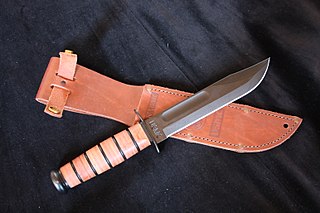
Ka-Bar is the contemporary popular name for the combat knife first adopted by the United States Marine Corps in November 1942 as the 1219C2 combat knife, and subsequently adopted by the United States Navy as the U.S. Navy utility knife, Mark 2. Ka-Bar is the name of a related knife manufacturing company, Ka-Bar Knives., Inc., of Olean, New York, a subsidiary of the Cutco Corporation.






















